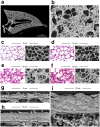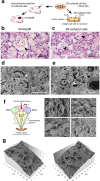Informative three-dimensional survey of cell/tissue architectures in thick paraffin sections by simple low-vacuum scanning electron microscopy
- PMID: 29748574
- PMCID: PMC5945589
- DOI: 10.1038/s41598-018-25840-8
Informative three-dimensional survey of cell/tissue architectures in thick paraffin sections by simple low-vacuum scanning electron microscopy
Abstract
Recent advances in bio-medical research, such as the production of regenerative organs from stem cells, require three-dimensional analysis of cell/tissue architectures. High-resolution imaging by electron microscopy is the best way to elucidate complex cell/tissue architectures, but the conventional method requires a skillful and time-consuming preparation. The present study developed a three-dimensional survey method for assessing cell/tissue architectures in 30-µm-thick paraffin sections by taking advantage of backscattered electron imaging in a low-vacuum scanning electron microscope. As a result, in the kidney, the podocytes and their processes were clearly observed to cover the glomerulus. The 30 µm thickness facilitated an investigation on face-side (instead of sectioned) images of the epithelium and endothelium, which are rarely seen within conventional thin sections. In the testis, differentiated spermatozoa were three-dimensionally assembled in the middle of the seminiferous tubule. Further application to vascular-injury thrombus formation revealed the distinctive networks of fibrin fibres and platelets, capturing the erythrocytes into the thrombus. The four-segmented BSE detector provided topographic bird's-eye images that allowed a three-dimensional understanding of the cell/tissue architectures at the electron-microscopic level. Here, we describe the precise procedures of this imaging method and provide representative electron micrographs of normal rat organs, experimental thrombus formation, and three-dimensionally cultured tumour cells.
Conflict of interest statement
The authors declare no competing interests.
Figures








References
-
- Stoltz JF, Zhang L, Ye JS, De Isla N. Organ reconstruction: Dream or reality for the future. Biomed Mater. Eng. 2017;28:S121–S127. - PubMed
MeSH terms
Substances
LinkOut - more resources
Full Text Sources
Other Literature Sources
Research Materials

